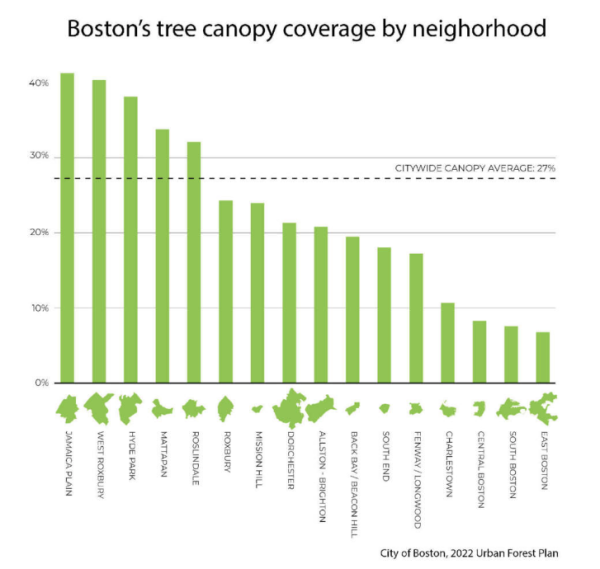December 28, 2023

Boston has its first tree ordinance. It contains rules about when trees can be trimmed or removed from city-owned parks, the land around schools, libraries, and public housing. It does not apply to trees on private property, which comprise half or more of Boston’s tree canopy. The new law is the city’s latest effort to better protect trees, which provide shade, clean the air, and remove carbon emissions.
City leaders say more trees are a key piece of the city’s plan to cope with longer, hotter summers.
“The ultimate goal is to have a climate-resilient urban forest that is thriving,” said Kat Eshel, chief of staff at Boston’s Office of Environment, Energy and Open Space. “Our canopy is connected to the health of our residents and well-being of our communities.”
The public ordinance turns a patchwork of rules into comprehensive regulations for trees managed by the city. Construction projects on city-owned land will have to include a survey of all trees on the site with a trunk three inches in diameter or wider. Healthy trees can’t be trimmed or removed without public notice and a hearing. A tree’s root zone, measured in relation to the size of its trunk, is also protected. There’s an appeal process, in some cases, for neighbors who disagree with city plans to cut down trees.
City trees that line streets are already covered by a state preservation law. The Boston ordinance expands and clarifies those rules. If a healthy street tree is removed in Boston, for example, it must be replaced by one or more of the equivalent size and species and be planted in the same neighborhood. The city’s tree warden will manage replacements.
The ordinance establishes rules in line with Boston’s Urban Forest Plan – a 20-year project that has more than tripled the number of city employees caring for existing trees and planting new ones. One of the plan’s goals is to close the gap between neighborhoods like Jamaica Plain, where 43 percent of the area is covered by trees, and East Boston, where that figure is 7 percent and treeless blocks bake during warm months.
Across Boston there’s an average of 27 percent tree cover. However, some neighborhoods have under 10 percent canopy cover. Some environmental advocates say that the city won’t make significant progress in closing that gap until it adopts rules for trees on private as well as public land.
“We believe that public and private trees should have been in one ordinance,” said Mimi Turchinetz, president of the Hyde Park Neighborhood Association, who is skeptical now that the city will create rules for privately owned trees. “It will be even more controversial and far more divisive.”
A private tree ordinance would have to consider the different responsibilities of homeowners and renters, Boston’s wide income disparities, and the cost of dealing with tree management. It could also face objections from residents. And there’s the challenge of enforcing rules in tens of thousands of individual properties and yards.
“It’s my hope that the city works creatively to figure out a way to do that,” said Boston City Councillor Ricardo Arroyo, who co-sponsored the public tree ordinance that passed in mid-December. “The goal is to protect all trees.”
Eshel said the city started with rules for public trees so it could “lead by example. That was our first priority,” she said, “before getting to those more complicated discussions about trees on private property.”
Some advocates who contributed ideas to the public tree ordinance say it should have strong enforcement and fines for violators. They say it will be difficult, politically, to add those elements to a private tree ordinance if they aren’t in the public tree rules.
But David Meshoulam of Speak for the Trees, Boston, said there’s excitement, too, that the value of each tree on public land in Boston will be seen and valued.
“These are fantastic steps forward,” said Meshoulam. “We’ll have to see if this changes how the city of Boston thinks about and preserves trees.”
This article was originally published by WBUR 90.9FM on its website on Dec. 20. The Reporter and WBUR share content through a media partnership.


